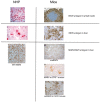Mouse models for filovirus infections
- PMID: 23170168
- PMCID: PMC3499815
- DOI: 10.3390/v4091477
Mouse models for filovirus infections
Abstract
The filoviruses marburg- and ebolaviruses can cause severe hemorrhagic fever (HF) in humans and nonhuman primates. Because many cases have occurred in geographical areas lacking a medical research infrastructure, most studies of the pathogenesis of filoviral HF, and all efforts to develop drugs and vaccines, have been carried out in biocontainment laboratories in non-endemic countries, using nonhuman primates (NHPs), guinea pigs and mice as animal models. NHPs appear to closely mirror filoviral HF in humans (based on limited clinical data), but only small numbers may be used in carefully regulated experiments; much research is therefore done in rodents. Because of their availability in large numbers and the existence of a wealth of reagents for biochemical and immunological testing, mice have become the preferred small animal model for filovirus research. Since the first experiments following the initial 1967 marburgvirus outbreak, wild-type or mouse-adapted viruses have been tested in immunocompetent or immunodeficient mice. In this paper, we review how these types of studies have been used to investigate the pathogenesis of filoviral disease, identify immune responses to infection and evaluate antiviral drugs and vaccines. We also discuss the strengths and weaknesses of murine models for filovirus research, and identify important questions for further study.
Keywords: Ebola; Marburg; filovirus; hemorrhagic fever; mouse models.
Figures


Similar articles
-
Tissue and cellular tropism, pathology and pathogenesis of Ebola and Marburg viruses.J Pathol. 2015 Jan;235(2):153-74. doi: 10.1002/path.4456. J Pathol. 2015. PMID: 25297522 Review.
-
Animal models for filovirus infections.Zool Res. 2018 Jan 18;39(1):15-24. doi: 10.24272/j.issn.2095-8137.2017.053. Zool Res. 2018. PMID: 29511141 Free PMC article. Review.
-
Drug targets in infections with Ebola and Marburg viruses.Infect Disord Drug Targets. 2009 Apr;9(2):191-200. doi: 10.2174/187152609787847730. Infect Disord Drug Targets. 2009. PMID: 19275706 Review.
-
A small nonhuman primate model for filovirus-induced disease.Virology. 2011 Nov 25;420(2):117-24. doi: 10.1016/j.virol.2011.08.022. Epub 2011 Sep 28. Virology. 2011. PMID: 21959017 Free PMC article.
-
Considerations in the Use of Nonhuman Primate Models of Ebola Virus and Marburg Virus Infection.J Infect Dis. 2015 Oct 1;212 Suppl 2(Suppl 2):S91-7. doi: 10.1093/infdis/jiv284. Epub 2015 Jun 10. J Infect Dis. 2015. PMID: 26063223 Free PMC article.
Cited by
-
Animal models for Ebola and Marburg virus infections.Front Microbiol. 2013 Sep 5;4:267. doi: 10.3389/fmicb.2013.00267. Front Microbiol. 2013. PMID: 24046765 Free PMC article. Review.
-
The Utility of Human Immune System Mice for High-Containment Viral Hemorrhagic Fever Research.Vaccines (Basel). 2020 Feb 22;8(1):98. doi: 10.3390/vaccines8010098. Vaccines (Basel). 2020. PMID: 32098330 Free PMC article. Review.
-
Type I interferon receptor knockout mice as models for infection of highly pathogenic viruses with outbreak potential.Zool Res. 2018 Jan 18;39(1):3-14. doi: 10.24272/j.issn.2095-8137.2017.052. Zool Res. 2018. PMID: 29511140 Free PMC article.
-
A Single Amino Acid Change in the Marburg Virus Matrix Protein VP40 Provides a Replicative Advantage in a Species-Specific Manner.J Virol. 2015 Nov 18;90(3):1444-54. doi: 10.1128/JVI.02670-15. Print 2016 Feb 1. J Virol. 2015. PMID: 26581998 Free PMC article.
-
Characterization of Ravn virus viral shedding dynamics in experimentally infected Egyptian rousette bats (Rousettus aegypticus).J Virol. 2025 May 20;99(5):e0004525. doi: 10.1128/jvi.00045-25. Epub 2025 Apr 23. J Virol. 2025. PMID: 40265897 Free PMC article.
References
-
- Kuhn J.H., Becker S., Ebihara H., Geisbert T.W., Johnson K.M., Kawaoka Y., Lipkin W.I., Negredo A.I., Netesov S.V., Nichol S.T., et al. Proposal for a revised taxonomy of the family Filoviridae: Classification, names of taxa and viruses, and virus abbreviations. Arch. Virol. 2010;155:2083–2103. doi: 10.1007/s00705-010-0814-x. - DOI - PMC - PubMed
-
- Kuhn J.H., Becker S., Ebihara H., Geisbert T.W., Jahrling P.B., Kawaoka Y., Netesov S.V., Nichol S.T., Peters C.J., Volchkov V.E., Ksiazek T.G. Virus Taxonomy—Ninth Report of the International Committee on Taxonomy of Viruses. Elsevier/Academic Press; San Diego, CA, USA: 2011. Family Filoviridae; pp. 665–671.
Publication types
MeSH terms
LinkOut - more resources
Full Text Sources
Medical
Research Materials
Miscellaneous

